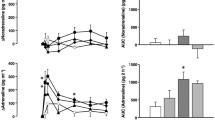Summary
Experiments were carried out using the blood perfusedLangendorff dog heart preparation to determine if myocardial tissue can convert angiotensin I to angiotensin II. The administration of angiotensin I directly into the main coronary artery of the isolated heart was accompanied by an immediate increase in coronary resistance. The increase in resistance caused by the injection of angiotensin I was prevented by the simultaneous administration of antibody to angiotensin II or by converting enzyme inhibitor. These experiments clearly demonstrate that the heart can convert angiotensin I to angiotensin II and suggest a possible role for these peptides in controlling coronary blood flow.
Zusammenfassung
Am modifiziertenLangendorff-Präparat des Hundes wurde untersucht, ob das Herz in der Lage ist, Angiotensin I in Angiotensin II umzuwandeln. Die Injektion von Angiotensin I in die Koronararterie des isolierten Herzens hat einen sofortigen Anstieg des koronaren Gefäßwiderstandes zufolge. Die durch die intrakoronare Angiotensin I-Injektion verursachte Widerstandserhöhung kann sowohl durch die gleichzeitige Gabe von Antikörpern gegen Angiotensin II als auch durch die Verabfolgung von „Converting-enzyme”-Inhibition verhindert werden. Die Versuche beweisen, daß das Herz Angiotensin I in Angiotensin II umwandeln kann, und lassen vermuten, daß diese Peptide für die Steuerung der koronaren Durchblutung von Bedeutung sein könnten.
Similar content being viewed by others
References
Franklin, W. G., M. J. Peach andJ. P. Gilmore, Evidence for the renal conversion of angiotensin I in the dog. Circulat. Res.27, 321–324 (1970).
Huggins, C. G. andN. S. Thampi, A simple method for the determination of angiotensin I converting enzyme. Life Sci.7, 633–639 (1968).
Gilmore, J. P. andE. D. Gerlings, The influence of developed tension on myocardial potassium balance in the dog heart. Circulat. Res.22, 769–775 (1968).
Bakhle, Y. S., Conversion of angiotensin I to angiotensin II by cell-free extracts of dog lung. Nature (London)220, 919 (1968).
Ng, K. K. F. andJ. R. Vane, Conversion of angiotensin I to angiotensin II. Nature216, 762–766 (1967).
Oparil, S., C. A. Sanders andE. Haber, In vivo and in-vitro conversion of angiotensin II in dog blood. Circulat. Res.26, 591–599 (1970).
Roth, M., A. F. Weitzman andY. Piquilloud, Converting enzyme content of different tissues of the rat. Experientia252, 1247 (1969).
Cushman, D. W. andH. H. Cheung, Concentrations of angiotensin-converting enzyme in tissues of the rat. Biochem. Biophys. Acta250, 261–265 (1971).
Author information
Authors and Affiliations
Additional information
With 3 figures and 1 table
Supported by Nebraska Heart Grant-in-Aid Award
Rights and permissions
About this article
Cite this article
Gerlings, E.D., Gilmore, J.P. Evidence for myocardial conversion of angiotensin I. Basic Res Cardiol 69, 222–227 (1974). https://doi.org/10.1007/BF01906203
Received:
Issue Date:
DOI: https://doi.org/10.1007/BF01906203




